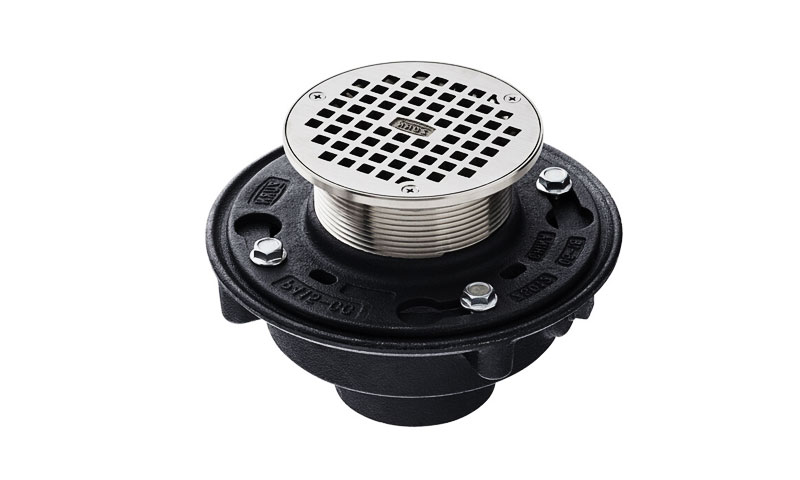1. مقدمة
Stainless steel casting floor drains combine corrosion resistance, mechanical strength and hygienic surface properties that make them ideal for demanding commercial, industrial and food-processing environments.
Typical cast alloys (CF8/CF8M equivalents of 304/316) offer robust performance in wet, chloride-bearing and chemically aggressive services; specialty castings (دوبلكس مقاوم للصدأ, cast 316L, or cast alloys with improved machinability) are used where service conditions, loads or regulatory requirements demand it.
Proper grade selection, طريقة الصب, surface finish and installation determine long service life and low maintenance.
2. Why Choose Stainless Steel Casting Floor Drains?
Main advantages
- مقاومة تآكل متفوقة vs cast iron or coated steels — especially in chloride, alkaline or chemical washdown environments.
- صحة: stainless does not support microbial growth as readily as porous coatings; smooth finishes are easy to sanitize.
- Long life / صيانة منخفضة: less frequent replacement, lower risk of rust staining or structural failure.
- Recyclability and appearance: long serviceable life and attractive finish useful in public/commercial spaces.
When stainless is preferred
- Food and beverage processing, commercial kitchens, pharmaceutical and healthcare facilities, marine and coastal installations, النباتات الكيميائية, and anywhere repeated wet cleaning, caustic detergents or salt exposure occurs.
3. مواد & Grades Used for Cast Stainless Drains
The material selection for stainless-steel casting floor drains is critical for ensuring long-term corrosion resistance, القوة الميكانيكية, والامتثال للنظافة.
The choice of grade depends on بيئة الخدمة, التعرض الكيميائي, الحمل الميكانيكي, fabrication requirements, واعتبارات التكلفة.
يقذف فولاذ مقاوم للصدأ are preferred over wrought products in many cases due to the ability to produce complex shapes with integrated features such as traps, مصفاة, and sloped surfaces.

Common Cast Stainless-Steel Grades
Cast stainless-steel grades are generally specified to ASTM A351 المعايير. Below are the most frequently used alloys:
| Cast Designation | رقم UNS | ما يعادلها | الميزات الرئيسية | التطبيقات النموذجية |
| CF8 | S30400 | 304 | أوستنيتي; مقاومة تآكل عامة ممتازة; قوة ميكانيكية جيدة; اقتصادي | Indoor floor drains, general-purpose sanitary drains |
| CF8M | S31600 | 316 | Austenitic with 2–3% Mo; superior pitting and crevice corrosion resistance | Coastal, البحرية, chemical plant, and food-processing drains |
| CF3 / CF3M | 304ل / 316ل ما يعادلها | Low-carbon versions of CF8 / CF8M | تحسين قابلية اللحام وتقليل خطر التحسس | Welded installations, areas with onsite fabrication |
| Duplex Cast | S31803 / S32205 | مزدوجة الفولاذ المقاوم للصدأ | Mixed austenite–ferrite microstructure; قوة عالية; excellent chloride resistance | Heavy-duty, كيميائية, أو بيئات كلوريد عالية; exterior or coastal installations |
| Special Machinable Castings | يختلف (Ni–Cu alloys, machinable CF8M) | - | Alloyed for enhanced machinability; may have slightly lower corrosion resistance | Customized or precision drains requiring post-cast machining |
4. Casting processes and post-cast finishing

Common casting routes
- استثمار (خاسر الشمع) صب: yields excellent dimensional accuracy, التفاصيل الدقيقة (فتحات ضيقة), and good surface finish — preferred for architectural/drain grates and precision trap bodies.
- صدَفَة / resin-bonded sand casting: cost-effective for moderate complexity parts with good finish; commonly used for housings and larger drain bodies.
- Green-sand casting: economical for large simple parts; may require more machining and finishing.
Post-cast operations
- المعالجة الحرارية / الحل الصلب: relieves stresses and restores corrosion resistance after welding; recommended for many cast austenitics. Typical practice: solution anneal and quench per material spec.
- الآلات and slot formation: drain slots, flange faces and trap interfaces machined to tolerance.
- التشطيب السطح: طحن, ساتان الانتهاء, انفجار حبة, الصدمة الكهربائية. Surface roughness targets depend on hygiene requirements (see Section 7).
- التخميل: التخميل الكيميائي (حمض النيتريك أو الستريك) removes free iron and enhances the passive film; often specified after welding or fabrication.
5. ميكانيكي & hydraulic design considerations
Load classes and structural strength
Floor drains must match expected loadings — pedestrian, light vehicle, or heavy-traffic.
For access covers and grates, many regions use في 124 load classes as a reference (globally recognized):
- A15 — up to 1.5 ر (pedestrian, bicycles)
- B125 — up to 12.5 ر (car parks)
- C250, D400, E600, F900 — progressively larger loads (trucks, heavy industrial).
Guideline: choose drain tops/grates and seatings manufactured and certified to the appropriate load class.
For floor drains integrated into traffic areas, a cast duplex or thick CF8M grate may be required.
السعة الهيدروليكية & grate design
- Slot area & free area: free area is the total open area through the grate; hydraulic capacity is directly proportional to free area for a given head.
Narrow slot designs (for safety/footwear) reduce capacity and increase clog risk. - Typical practice: ensure free area matches expected peak inflow (washdown or storm runoff) with margin; refer to local plumbing codes for sanitary or storm flow rates.
- Debris handling: incorporate trap baskets or removable strainers to collect solids and facilitate maintenance.
Trap seals and backflow prevention
- Internal traps prevent sewer gas entry. Where drains may be subject to backflow, consider backwater valves or floor check valves.
For high hygiene facilities, trap designs that are easy to remove and clean are preferred.
6. تآكل, يرتدي, and Contamination
Pitting and crevice corrosion — why 316 often wins
When chlorides or aggressive ions are present, the passivity of stainless steels can break down and localized corrosion (الحفر / شق) يمكن أن يحدث.
A quantitative index commonly used is خشب (رقم ما يعادل مقاومة الحفر).
Approximate PREN examples (عادي):
- 304 (CF8): Cr ≈ 18, Mo ≈ 0 → PREN ≈ 18
- 316 (CF8M): Cr ≈ 17–18, Mo ≈ 2–3 → PREN ≈ 26 (تقريبا)
Higher PREN = better resistance to pitting / تآكل شق. When drains are exposed to seawater, chlorine or brines, CF8M (يقذف 316) is commonly recommended.
Galvanic contacts & الطلاء
Avoid mixing stainless drains with less noble metals (الزنك, الألومنيوم, الصلب الكربوني) in electrical contact where stray currents or wet conditions exist, unless insulated; galvanic couples can accelerate corrosion of the less noble metal and cause staining.
Erosion and mechanical wear
High-velocity washdown (على سبيل المثال, تنظيف الضغط العالي) can erode drain slots and edges over time — robust castings or hardened inserts mitigate wear. Duplex castings provide higher strength and wear resistance.
7. Hygienic and cleanability aspects
Surface finish targets
- General commercial: brushed/satin finishes often acceptable (ra ≈ 0.8 µm or 32 µin).
- طعام & الأدوية: smoother surfaces are desirable (Ra ≤ 0.4–0.8 µm).
Electropolishing can reduce Ra to ~0.2–0.4 µm, minimize microcrevices and improve cleanability. - Welds and joints: سلس, continuous weld profiles facilitate cleaning; post-weld passivation recommended.
Drain geometry and bacterial control
- Avoid dead legs or stagnant pockets in trap bodies and housings. Sloped interior surfaces and smooth transitions promote self-draining and reduce microbial harborage.
Chemical compatibility with cleaners
- Choose drain grade compatible with the facility’s cleaning chemicals (على سبيل المثال, high-concentration chlorinated bleaches can attack some alloys at elevated temperatures). CF8M resists many common detergents and sanitizers better than CF8.
8. Installation best practices and site considerations

تصاعد & bedding
- Install drains on a true, prepared concrete recess with proper fall to the drain inlet. Bedding mortars should be compatible and should not entrap moisture against the cast body.
لحام & thermal effects
- If welding to stainless piping or frames, control heat input and consider post-weld solution anneal for CF8/CF8M attachments in critical sanitary applications to avoid sensitization.
Specify CF3/CF3M (منخفض ج) where welding is frequent and sensitization is a concern.
الأختام & حشيات
- Use NSF/food-grade gaskets where required. Ensure seals are compatible with cleaning chemicals and temperatures.
Access for maintenance
- Provide adequate clearance and removable grates to access basket and trap for cleaning without disassembling adjacent equipment.
9. تقتيش, maintenance and troubleshooting
Routine checks
- Inspect and remove debris/strainers weekly in high-use areas; monthly checks in lower-use environments.
- Inspect for signs of pitting, تغير اللون, or weld crevice corrosion and address the cause (كيميائية, ميكانيكي, or stray current).
التخميل & تنظيف
- Periodic passivation (citric or nitric acid based) restores a clean passive layer after mechanical wear or welding. Electropolishing reduces maintenance frequency.
Common failure modes and remedies
- Pitting at slots or crevices: likely chloride exposure + insufficient alloy. علاج: upgrade to CF8M or duplex, improve cleaning and drainage to prevent standing salts.
- Galvanic staining: isolate dissimilar metals or use sacrificial anodes.
- Mechanical damage to grate / تشوه: verify load class and consider duplex castings or thicker grates.
10. يكلف, lifecycle and sustainability
Comparative costs
- Upfront cost: stainless castings (CF8/CF8M) typically cost more than cast iron or plastic drains.
- Lifecycle cost: أقل الصيانة, fewer replacements, less downtime — often results in lower total cost of ownership in corrosive/hygienic environments.
الاستدامة
- Stainless steel is highly recyclable; at end-of-life components are readily recycled into new stainless products. The embodied energy is amortized over long life and reuse.
11. Common Misconceptions About Stainless Steel Casting Floor Drains
“All Stainless Steel Drains Are the Same”
خطأ شنيع. 304 SS and 316L SS differ drastically in corrosion resistance—316L’s molybdenum content (2.5%) makes it 3x more resistant to chloride-induced pitting.
“Stainless Steel Drains Never Rust”
خطأ شنيع. 304 SS will pit in high-chloride environments (على سبيل المثال, معالجة الأغذية, البحرية) — rust-like spots are pitting corrosion, not “rust” (أكسيد الحديد).
“Investment Casting Is Too Expensive”
Context-dependent. For high-volume food/medical applications, investment casting eliminates post-machining and reduces maintenance costs—ROI achieved in 2–3 years vs. صب الرمال.
“Load Capacity Doesn’t Matter for Indoor Drains”
خطأ شنيع. Commercial buildings (على سبيل المثال, malls) experience heavy pedestrian traffic—under-sized Class A drains can crack, leading to water damage and safety hazards.
“Mechanical Traps Are Better Than Water Seals”
ليس دائما. Mechanical traps (flaps, balls) require maintenance (تنظيف, تشحيم) and can fail in dusty/industrial environments—water seals are more reliable for low-maintenance applications.
12. Comparison with Floor Drains Made of Other Materials
Selecting the right floor drain material is critical to balancing مقاومة التآكل, الأداء الميكانيكي, صحة, تكلفة دورة الحياة, والجماليات.
| ملكية / ميزة | الفولاذ المقاوم للصدأ (304 / 316 / Duplex Cast) | PVC / CPVC | الحديد الزهر (Grey / الدوقات) | الصلب المجلفن | النحاس / البرونز |
| مقاومة التآكل | ممتاز; resists pitting, شق, and chemical attack | Good in non-chloride water; limited chemical resistance | معتدل; prone to rust if coating fails | معتدل; zinc coating degrades over time | Good in potable water and mild corrosive environments |
| القوة الميكانيكية | High tensile/yield; مقاومة التأثير | قليل; brittle under load | High compressive; brittle under impact | معتدل | معتدل; الدوقات |
| صحة / التنظيف | Very hygienic; سلس, غير مسامي; electropolishable | معتدل; smooth but can scratch or trap biofilms | قليل; rough surfaces trap debris; يتطلب الطلاء | معتدل; can corrode and stain | سلس; خصائص مضادات الميكروبات; سهل التنظيف |
حرارة / المقاومة الكيميائية |
عالي; withstands hot water and cleaning chemicals | محدود (~60–90°C); chemical resistance varies | Heat resistant; limited chemical resistance | معتدل; susceptible to chemicals | معتدل; resistant to mild chemicals and heat |
| خدمة الخدمة النموذجية | 25-50+ سنوات | 10–20 years | 15-25 سنة | 10–15 years | 20–30 years |
| اعتبارات التكلفة | تكلفة أولية عالية; low lifecycle cost | Low upfront; higher maintenance over time | معتدل; coating maintenance needed | Low upfront; frequent maintenance | معتدلة إلى عالية; specialty or decorative use |
| التطبيقات النموذجية | طعام, المشروبات, فارما, البحرية, hospitals, high-traffic commercial | سكني, light commercial | Commercial, municipal stormwater, صناعي (non-food) | Industrial or commercial with light moisture/chemicals | طعام, المشروبات, زخرفية |
13. خاتمة
Stainless steel cast floor drains are a high-value option where corrosion resistance, hygiene and long life are priorities.
Selecting the right cast alloy (CF8 vs CF8M vs duplex), عملية الصب, surface finish and mechanical class, combined with correct installation and maintenance, delivers durable, low-maintenance drainage solutions for food, الأدوية, marine and industrial facilities.
Thoughtful specification and inspection — including grade verification, finish requirements and load classification — prevent common failures such as pitting, galvanic attack and mechanical damage.
الأسئلة الشائعة
Which stainless grade is best for an outdoor drain on a coastal pier?
يقذف 316 (CF8M) is typically recommended for coastal environments because Mo enhances resistance to pitting from chlorides.
For very aggressive marine service consider cast duplex for higher strength and chloride resistance.
Can I weld a CF8 drain to carbon steel piping?
نعم, with appropriate joint design and isolation to prevent galvanic corrosion. Use compatible filler metals and consider insulating flange connections; avoid direct contact without electrical isolation.
How often should drain baskets be cleaned?
High-use kitchens: daily; commercial/retail floor drains: weekly; light-use areas: monthly — adapt frequency to observed debris accumulation.
Is electropolishing necessary?
ليس دائما, but electropolishing improves cleanability and reduces microbial adhesion — recommended in food, pharmaceutical and medical environments.
What load class should I specify for a public restroom drain?
عادة A15 (pedestrian) is adequate for restrooms; if the area may see carts or service vehicles specify B125 or higher as required.


